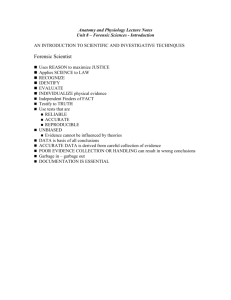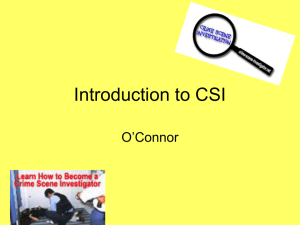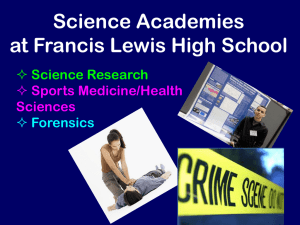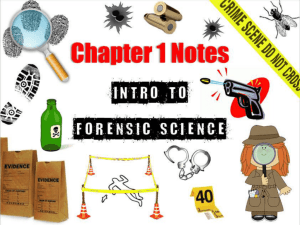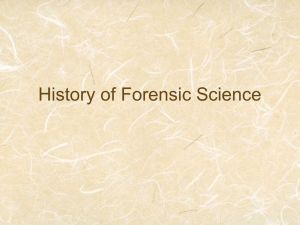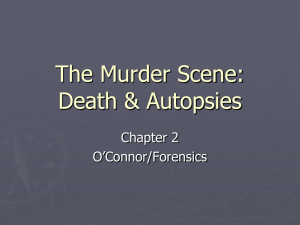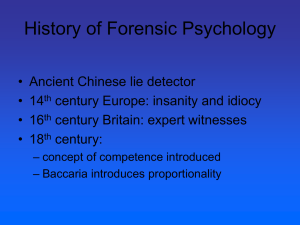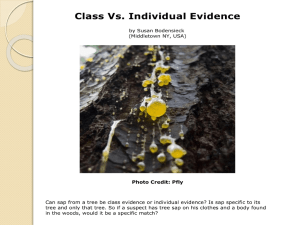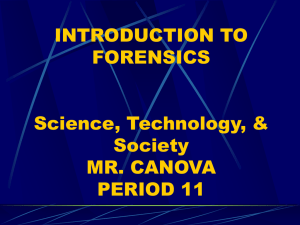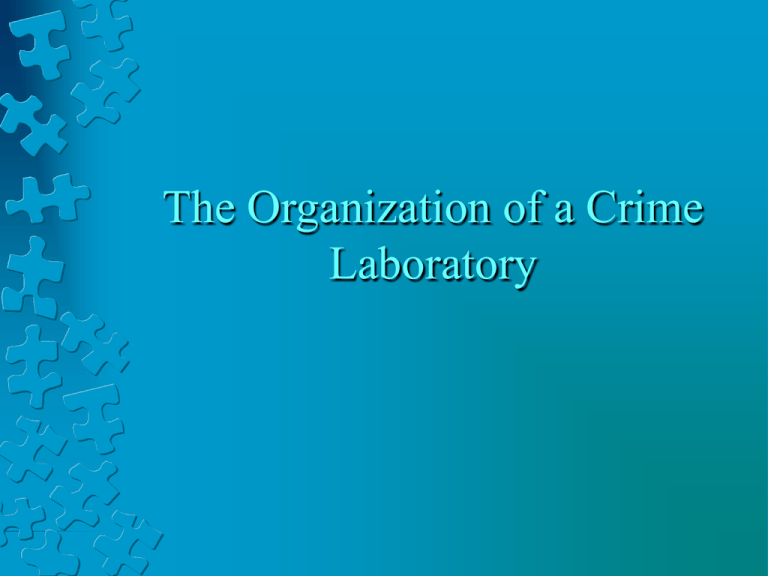
The Organization of a Crime
Laboratory
Growth
• There are approximately 320 crime labs in
the US; more than 3 times the number than
in 1966
Reasons for Growth
• Increasing growth of physical evidence
recovered from crime scenes as a result of
rising crime rates.
• The need to perform chemical analysis on
drugs, coupled with a significant increase in
illicit drug seizures (all drug seizures must
have confirmatory chemical analysis before
case can go to court)
• Supreme Court decisions have enhanced the
rights of the defendant’s right to counsel
and right to remain silent, have encouraged
police agencies to place a greater reliance
on scientific investigative techniques.
• Advances in scientific technology have
provided forensic scientists with many new
skills and techniques to extract meaningful
information from physical evidence. (DNA
profiling)
Organization
• Sizes vary from staff of 1 to 100
• Labs in the US are decentralized, under the
direction of federal, state, county, and
municipal governments
Federal Crime Laboratories
• FBI – largest crime lab in the world, broad investigative
powers
• DEA – analysis of drugs seized in violation of federal laws
regulating production, sale & transport, of drugs
• Bureau of Alcohol, Tobacco, Firearms & Explosives –
analyzing alcoholic beverages & documents relating to tax
law enforcement & for examining weapons, explosive
devices & related evidence received in conjunction with
enforcement of the Gun Control Act of 1968 & Organized
Crime Control Act of 1970
• U.S. Postal Inspection Service – criminal
investigations relating to the postal service.
State
• Most states maintain a crime lab to service
local agencies that don’t have access to one.
• Some states have statewide comprehensive
system of regional or satellite labs under the
direction of a central facility
Local
• Provide service to county & municipal
agencies
• Usually independent of state and financed
by local government
Services of the “Full Service” Crime
Lab
1. Physical Science Unit:
a. Identifies & conducts comparisons of crimescene evidence
b. Items examined include:
a. Drugs
b. Glass
c. Paint
d. explosives
e. soil
f. trace evidence
2. Biology Unit:
a. Identification & DNA profiling from
body fluids
b. comparison of hair & fibers
c. identification & comparison of botanical
materials, such as wood and plants
3. Firearms unit:
a. examination of firearms, discharged
bullets, cartridge cases, shotgun shells, and
ammunition of all types
b. examination of garments and other
objects in order to detect firearm discharge
residues & to approximate the distance from
a target at which a weapon was fired
c. examination of marks made by tools
4. Document Examination Unit
a. handwriting & typing of questioned
documents
b. analysis of ink, partially visible
depressions on sheet of paper underneath
one written on, obliterations, erasures &
burned/charred docs
5. Photography Unit:
a. examine & record physical evidence
b. Prepare photographic exhibits for
courtroom presentations
c. may use special photographic techniques
(digital imaging, infrared, UV photography,
X-ray photography) to make information
invisible to naked eye become visible
Optional services provided by full
service lab
1. Toxicology unit – examine body fluids &
organs to determine presence of drugs &
poisons (may be done at Medical Examiners
or Coroner’s office). This department may
train operator’s & maintain field
instruments like Intoxilyzer (determines
alcohol level)
2. Latent Fingerprint Unit – process and
examine evidence for latent fingerprints
when they are submitted in conjunction
with other lab examinations
3. Polygraph Unit – “lie detector”- more a tool
of criminal investigator than forensic
scientist, often found in the forensic lab
4. Voiceprint Analysis Unit – use sound
spectograph to turn speech into visual
graphic display called voiceprint – displays
the uniqueness of individual sound patterns
5. Evidence Collection Unit – evidence
collection by forensic science service is
gaining recognition. Trained personnel
collect & preserve physical evidence for
processing at lab.
Functions of the Forensic Scientist
A. Analysis of Physical Evidence – refer to pg 13
figure 1-3
1. Apply scientific techniques to analysis of evidence
2. Be aware of demands and constraints of legal system
a. Frye v United States: set precedent Court must decide if the
questioned procedure/technique/principle is “generally
accepted” by a meaningful segment of the scientific
community
b. Daubert v Merrell Dow
Pharmaceutical, Inc.: US Supreme Court
asserted that in assessing the admissibility
of new and unique scientific tests the trial
judge did not have to rely solely on the
concept of “general acceptance” (of the
Frye Standard)
c. Kumho Tire Co, Ld v Carmichael –
the Court rated that the “gatekeeping” role
of the trail judge applied not only to
scientific evidence, but to all expert
testimony
B. Provision of expert testimony
1. Expert witness – an individual whom the court
determines possesses knowledge relevant to the
trial that is not expected of the average lay person
2. Competency shown by degrees held,
professional organizations belong to, professional
articles published, years of experience,
participation in special courses
3. Opposing attorney may cross-examine the
witness & point out weaknesses in background or
knowledge
4. Laypersons testifying may not state their
opinion, but an expert witness can
C. Furnishing Training in the Proper
Recognition, Collection, & Preservation of
Physical Evidence
1. often have Evidence Technicians on 24
hour call to aid criminal investigations in
retrieving evidence
2. where patrol officers or detectives gather
the evidence, forensic scientist should train
all officers engaged in fieldwork
Other Forensic Science Services
1. Forensic pathology – investigation of
sudden, unnatural, unexplained or violent
deaths. Primary role of medical examiner
or coroner is to establish cause of death. If
can’t establish through observation, may
do autopsy
a. Manner of death categories: natural, homicide,
suicide, accident, undetermined
b. stages of decomposition (to estimate time of
death)
1. rigor mortis – the medical condition
that occurs after death & results in shortening of
muscle tissue & stiffening of body parts in the
position they are in when death occurs, appears @
24h, disappears @36h
2. livor mortis – the medical condition
that occurs after death and results in blood settling
in the body in areas closest to the ground. Begins
immediately & continues for up to 12h after death
(skin does not appear discolored in areas where
the body is restricted by clothes, or object pressed
against body). Helps determine if body has been
moved.
3. algor mortis – post mortem changes that
cause a body to lose heat – cools until reaches
room temp. Rate is influenced by factors (size of
body, weather condition, clothes, etc.) so not
precise, but drops about 1.5 degrees F per hr.
4. potassium levels in ocular fluid (vitreous
humor) after death, cells inside eye release K into
ocular fluid. Analyze amount of K present
@various intervals after death to determine rate of
K released into vitreous humor, thus can estimate
time of death
5. amount of food in stomach determines
when last meal eaten
2. Forensic Anthropology – identification and
examination of human skeletal remains.
Reveals origin, sex, approximate age, race
& skeletal injury; may create facial
reconstruction
3.Forensic Entomology – study of insects &
their relation to criminal investigation
- estimate time of death by blow fly life
cycles (refer to pg 21 figure 1-5)
- affected by weather conditions & climate
4. Forensic Psychiatry – relationship between
human behavior – legal proceedings is
examined.
- civil cases – determine whether people are
competent to make decisions re: will,
settling property, refuse medical treatment
- criminal cases – evaluate behavioral
disorders, determine whether competent to
stand trial
- Also examine behavioral patterns, develop
criminal profile
5. Forensic Odontology – identification of
victims by examining teeth, dental records.
Also analyze bite marks, compare to
suspect’s teeth structure (refer to pg 22
figure 1-6) Bite marks are less likely to be
found in cases of arson
6. Forensic Engineering – failure analysis,
accident reconstruction, causes & origins of
fires or explosions, Who was responsible?

